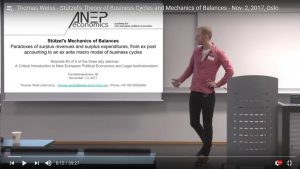Stützel’s goal was to render superflous the controversy between Keynesians and Anti-Keynesians by demonstrating precisely for which special cases each group is correct and for which special cases each group overgeneralizes. Thomas Weiss’ presentation shows the first part of how he accomplished that.
To view the video, click on the image. Read a short summary below.
Summary: Ex post, within a closed economy the sum of all increases of net financial assets (positive balances on current account) and the sum of all decreases of net financial assets (negative balances on current account) are always equal by accounting identity, since net financial assets of the world as a whole always equal zero. PLANNED aggregate expenditures (planned decreases of net financial assets) and PLANNED aggregate revenues (planned increases of net financial assets), however, are not necessarily equal since legal persons plan independently from one another on the basis of subjective, uncertain future expectations.
If in the aggregate, plans to to increase net financial assets (to achieve positive balances on current account) prevail, aggregate supply (for goods and services) is greater than aggregate demand. This will reduce existing seller’s markets and eventually lead to buyer’s markets, or increase already existing buyer’s market tensions. If in the aggregate, plans to decrease net financial assets (to achieve deficits on current account) prevail, aggregate demand (for goods and services) is greater than aggregate supply. This will reduce existing buyer’s market tensions and eventually lead to seller’s markets, or increase already existing seller’s market tensions.
On buyer’s markets, aggregate planned expenditures (“aggregate demand”) will determine which revenues can be realized – in this special situation, Keynesian demand economics holds true. Thus, on existing buyer’s markets, if aggregate plans change from planned increases of net financial assets to planned decreases of net financial assets because the state announces plans to decrease its net financial assets (deficit spending), output and employment will increase. On seller’s markets, however, planned revenues (“aggregate supply”) will determine which expenditures can be realized. This is where Keynesian demand stimulus policy breaks down, and government austerity (as well as a central bank interest rate above the market rate) is needed to boost output & employment. Stagflation during the 1970s may be a historical example for such a special situation, as well as other highly inflationary historical situations (such as today’s Venezuela).
The fourth presentation by Prof. Johannes Schmidt, Karlsruhe (coming soon) will present the second part of Stützel’s Theory of business cycles, introducing the concept of lockstep of revenues and expenditures (increases and decreases of net financial assets) and receipts and payments (increases or decreases of the stock of means of payment). Lockstep means inflows and outflows equal each other for a period so there is no change in stocks of net financial assets or means of payment (or both). While this is always true for a closed economy as a whole, for partial groups inflows and outflows will often deviate from each other, lockstep being the exception. Lockstep or deviation effects can happen independently of each other on the level of net financial assets and means of payment, yielding 4 possible combinations. Schmidt shows that current macroeconomic theories each describe one of those 4 special cases. Thus, they are not really theoretical alternatives, but can be integrated as special cases into Stützel’s General Theory.
This General Theory is based on standard, precise empirical business and national accounting categories, one original concept (lockstep of inflows and outflows of means of payment and net financial assets), and a few realistic behavioral assumptions taken from everyday business practice.

